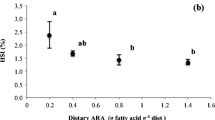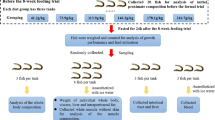Abstract
The effects of different lipids on tissue fatty acid profile and reproductive performance in female rice field eel were investigated in this study. Virgin female eels were fed with six diets containing different lipids (diets FO, LO, SO, PO and PL with fish oil, linseed oil, soybean oil, peanut oil and pork lard, respectively; diet APO with arachidonic acid and peanut oil). The results showed that there were positive correlations between the contents of 18:2n-6, 18:3n-3, arachidonic acid (ARA), eicosapentaenoic acid (EPA) and docosahexaenoic acid (DHA) in the tissues of eels and those of the corresponding fatty acids in their diets. The specific growth rate of eels fed with diet PO was the lowest and significantly lower than that of FO and SO. Gonad of eels fed with diets PO and PL showed hypogonadism. The long chain polyunsaturated fatty acids (LC-PUFA) can be synthesized by eels, but the quantity was not enough to meet their reproduction requirement completely. The fatty acid desaturation, rather than elongation probably was one of the limiting factors. Addition of proper amount of ARA in diet was favorable to the increase of the hatching rate of fertilized eggs, while EPA and DHA in diet were beneficial to the increase of the survival rate of larva. Both n-3PUFA and a suitable n-6/n-3PUFA ratio were necessary for growth and reproduction of eels.


Similar content being viewed by others
Abbreviations
- ARA:
-
Arachidonic acid, 20:4n-6
- ANOVA:
-
Analysis of variance
- APO:
-
Contained arachidonic acid and peanut oil diet
- BHT:
-
Butylated hydroxytoluene
- DHA:
-
Docosahexaenoic acid, 22:6n-3
- DPH:
-
Days past hatching
- EFA:
-
Essential fatty acid
- EPA:
-
Eicosapentaenoic acid, 20:5n-3
- FAME:
-
Fatty acid methyl esters
- FO:
-
Contained fish oil diet
- GSI:
-
Gonadosomatic index (%)
- HSI:
-
Hepatosomatic index (%)
- LC-PUFA:
-
Long chain polyunsaturated fatty acids (carbon chain length ≥C20 with ≥3 double bonds)
- LO:
-
Contained linseed oil diet
- MUFA:
-
Monounsaturated fatty acids
- PL:
-
Contained pork lard diet
- PO:
-
Contained peanut oil diet
- PUFA:
-
Polyunsaturated fatty acids
- SAI:
-
Survival activity index
- SGR:
-
Specific growth rate
- SFA:
-
Saturated fatty acid
- SO:
-
Contained soybean oil diet
- VSI:
-
Viscerosomatic index (%)
References
Bell JG, Sargent JR (2003) Arachidonic acid in aquaculture feeds: current status and future opportunities. Aquaculture 218:491–499
Bell JG, Tocher DR, Sargent JR (1994a) Effect of supplementation with 20:3(n-6), 20:4(n-6) and 20:5(n-3) on the production of prostaglandins E and F of the 1-, 2- and 3-series in turbot (Scophthalmus maximus) brain astroglial cell in primary culture. Biochim Biophys Acta 1211:335–342
Bell JG, Tocher DR, MacDonald FM, Sargent JR (1994b) Effects of diets rich in linoleic (18:2n–6) and linolenic (18:3n–3) acids on the growth, lipid class and fatty acid compositions and eicosanoid production in juvenile turbot (Scophthalmus maximus). Fish Physiol Biochem 13:105–118
Bell JG, Tocher DR, Farndale BM, McVicar AH, Sargent JR (1999) Effects of essential fatty acid-deficient diets on growth, mortality, tissue histopathology and fatty acid compositions in juvenile turbot (Scophthalmus maximus). Fish Physiol Biochem 20:263–277
Bell JG, Henderson RJ, Tocher DR, McGhee F, Dick JR, Porter A, Smullen RP, Sargent JR (2002) Substituting fish oil with crude palm oil in the diet of Atlantic salmon (Salmo salar) affects muscle fatty acid compositions and hepatic fatty acid metabolism. J Nutr 132:222–230
Bing XW (2005) Artificial reproduction test of Monopterus albus under the imitation of natural breeding conditions. J Fish China 29:286–298 (in Chinese with English abstract)
Bing XW, Xu P (2003) Study on the ecological breeding technology of mud eel. J Ecol Anim 7:46–48 (in Chinese with English abstract)
Bransden MP, Carter CG, Nichols PD (2003) Replacement of fish oil with sunflower oil in feeds for Atlantic salmon (Salmo salar L.): effect on growth performance, tissue fatty acid composition and disease resistance. Comp Biochem Physiol 135B:611–625
Cheng H, Guo Y, Yu Q, Zhou R (2003) The rice field eel as a model system for vertebrate sexual development. Cytogenet Genome Res 101:274–277
Chew SF, Gan J, Ip YK (2005) Nitrogen metabolism and excretion in the swamp eel, Monopterus albus, during 6 or 40 days of estivation in mud. Physiol Biochem Zool 78:620–629
Farkas T, Csengeri I (1976) Biosynthesis of fatty acids by the carp, Cyprinus carpio in relation to environmental temperature. Lipids 11:401–407
Folch J, Lees M, Sloane-Stanley GH (1957) A simple method for the isolation and purification of total lipids from animal tissues. J Biol Chem 226:497–509
Francis DS, Turchini GM, Jones PL, De Silva SS (2006) Effects of dietary oil source on growth and fillet fatty acid composition of Murray cod (Maccullochella peelii peelii). Aquaculture 253:547–556
Furuita H, Tanaka H, Yamamoto T, Shiraishic M, Takeuchid T (2000) Effects of n-3 HUFA levels in broodstock diet on the reproductive performance and egg and larval quality of the Japanese flounder (Paralichthys olivaceus). Aquaculture 187:387–398
Furuita H, Yamamotoa T, Shima T, Suzukia N, Takeuchi T (2003) Effect of arachidonic acid levels in broodstock diet on larval and egg quality of Japanese flounder (Paralichthys olivaceus). Aquaculture 220:725–735
Ganga R, Bell JG, Montero D, Robaina L, Caballero MJ, Izquierdo MS (2005) Effect of dietary lipids on plasma fatty acid profiles and prostaglandin and leptin production in gilthead seabream (Sparus aurata). Comp Biochem Physiol 142B:410–418
Ghioni C, Tocher DR, Bell MV, Dick JR, Sargent JR (1999) Low C18 to C20 fatty acid elongase activity and limited conversion of stearidonic acid, 18:4n–3, to eicosapentaenoic acid, 20:5n–3, in a cell line from turbot (Scophthalmus maximus). Biochim Biophys Acta 1437:170–181
Guler GO, Kiztanir B, Aktumsek A, Citil OB, Ozparlak H (2008) Determination of the seasonal changes on total fatty acid composition and n-3/n-6 ratios of carp (Cyprinus carpio) muscle lipids in Beysehir Lake (Turkey). Food Chem 108:689–694
Jaya-Ram A, Kuah MK, Lim PS, Kolkovski S, Shu-Chien AC (2008) Influence of dietary HUFA levels on reproductive performance, tissue fatty acid profile and desaturase and elongase mRNAs expression in female zebrafish(Danio rerio). Aquaculture 277:275–281
Karapanagiotidis IT, Bell M, Little D, Yakupitiyage A (2007) Replacement of dietary fish oils by alpha-linolenic acid-rich oils lowers omega 3 content in tilapia flesh. Lipids 42:547–559
Koussoroplis AM, Lemarchand C, Bec A, Desvilettes C, Amblard C, Bourdier G (2008) From aquatic to terrestrial food webs: decrease of the docosahexaenoic acid/linoleic acid ratio. Lipids 43:461–466
Li YY, Chen WZ, Sun ZW, Chen JH, Wu K (2005) Effects of n-3 HUFA content in broodstock diet on spawning performance and fatty acid composition of eggs and larvae in (Plectorhynchus ciuctus). Aquaculture 24:263–272
Ling S, Kuah MK, Tengku Muhammad TS, Kolkovski S, Shu-Chien AC (2006) Effect of dietary HUFA on reproductive performance, tissue fatty acid profile and desaturase and elongase mRNAs in female swordtail (Xiphophorus helleri). Aquaculture 261:204–214
Liu CK (1944) Rudimentary hermaphroditism in the symbranchoid eel, Monopterus javanensis. Sinensia 15:1–8
Mazorra C, Bruce M, Bell JG, Davie A, Alorend E, Jordan N, Rees J, Papanikos N, Porter M, Bromage N (2003) Dietary lipid enhancement of broodstock reproductive performance and egg and larval quality in Atlantic halibut (Hippoglossus hippoglossus). Aquaculture 227:21–33
Rodriguez C, Perez JA, Henderson RJ (2002) The esterification and modification of n-3 and n-6 polyunsaturated fatty acids by hepatocytes and liver microsomes of turbot (Scophthalmus maximus). Comp Biochem Physiol 132B:559–570
Sargent J, Bell G, McEvoy L, Tocher D, Estevez A (1999) Recent developments in the essential fatty acid nutrition of fish. Aquaculture 177:191–199
Sargent JR, Tocher DR, Bell JG (2002) The lipids. In: Halver JE, Hardy RW (eds) Fish nutrition. Academic Press, San Diego, pp 182–257
Shimma H, Tsujigado A (1981) Some biochemical quality of bred scorpaenoid fish, Sebastiscus marmoratus, and activities of their larvae. Bull Natl Res Inst Aquac 2:11–20 (in Japanese with English abstract)
Tacon AGJ, Metian M (2008) Global overview on the use of fish meal and fish oil in industrially compounded aquafeeds: trends and future prospects. Aquaculture 285:146–158
Takeuchi T (1997) Essential fatty acid requirements of aquatic animals with emphasis on fish larvae and fingerlings. Rev Fish Sci 5:1–25
Takeuchi T, Watanabe T (1977) Requirement of carp for essential fatty acids. Bull Jpn Soc Sci Fish 43:541–551
Takeuchi T, Satoh S, Watanabe T (1983) Requirement of Tilapia nilotica for essential fatty acids. Bull Jpn Soc Sci Fish 49:1127–1134
Tocher DR, Agaba M, Hastings N, Bell JG, Dick JR, Teale AJ (2002a) Nutritional regulation of hepatocyte fatty acid desaturation and polyunsaturated fatty acid composition in zebrafish (Danio rerio) and tilapia (Oreochromis niloticus). Fish Physiol Biochem 24:309–320
Tocher DR, Fonseca-Madrigal J, Bell JG, Dick JR, Henderson RJ, Sargent JR (2002b) Effects of diets containing linseed oil on fatty acid desaturation and oxidation in hepatocytes and intestinal enterocytes in Atlantic salmon (Salmo salar). Fish Physiol Biochem 26:157–170
Wei QS, Wang XW, Wu HQ (1993) Study of food and inhabit environment of rice field eel. Hubei Agr Sci 10:23–25 (in Chinese)
Yin SW, Zhou GJ, Liu Y (2004) Effect of different ecological factors on rice field eel (Monopterus albus) hatching rate. Chin J Appl Ecol 15:734–736 (in Chinese with English abstract)
Yin SW, Zhou GJ, Liu Y (2005) Ecological study on the breeding of rice field eel, Monopterus albus. Acta Ecol Sin 25:435–440 (in Chinese with English abstract)
Yu TC, Sinnhuber RO, Hendricks JD (1979) Reproduction and survival of rainbow trout (Salmo gairdneri) fed linolenic acid as the only source of essential fatty acids. Lipids 14:572–575
Zhang YP, Xie XB (2007) Effect of different levels of fish oil on the growth and reproductive performance of rice field eel, Monopterus ablus. Fish Sci Jiangxi 111:1–5 (in Chinese)
Zhou R, Cheng H, Tiersch RT (2002) Differential genome duplication and fish diversity. Rev Fish Biol Fish 11:331–337
Zhou QB, Wu HD, Wu HQ, Yang FQ (2003) The embryonic and postembryonic of (Monopterus albus). J Fish China 27:505–512 (in Chinese with English abstract)
Zhou QB, Jin SM, Wu XB, Zhang YP, Yang FQ, Wu HD (2006) Effects of the water depth and illumination on the hatching rate of zygote of rice field eel (Monopterus albus). Freshw Fish 36:31–33 (in Chinese with English abstract)
Zhu BK, Cao WX (2002) Fatty acid composition and their changes during early life stage of silver carp, Hypophthalmichthys molitrix. Acta Hydro Sin 26:130–135 (in Chinese with English abstract)
Acknowledgments
This project was supported by the national natural science foundation of China (Grant No.30860217); the natural science foundation of Jiangxi province, China (Grant No.2008GZN0025); the open fund of key laboratory for genetic breeding of aquatic animals and aquaculture biology the ministry of agriculture, China(Grant No.BM2007-10). The authors would like to thank Dr. Hanhua HU at the Institute of Hydrobiology, Chinese Academy of Sciences for providing the technical assistance for this study.
Author information
Authors and Affiliations
Corresponding author
Rights and permissions
About this article
Cite this article
Zhou, QB., Wu, HD., Zhu, CS. et al. Effects of dietary lipids on tissue fatty acids profile, growth and reproductive performance of female rice field eel (Monopterus albus). Fish Physiol Biochem 37, 433–445 (2011). https://doi.org/10.1007/s10695-010-9444-1
Received:
Accepted:
Published:
Issue Date:
DOI: https://doi.org/10.1007/s10695-010-9444-1




